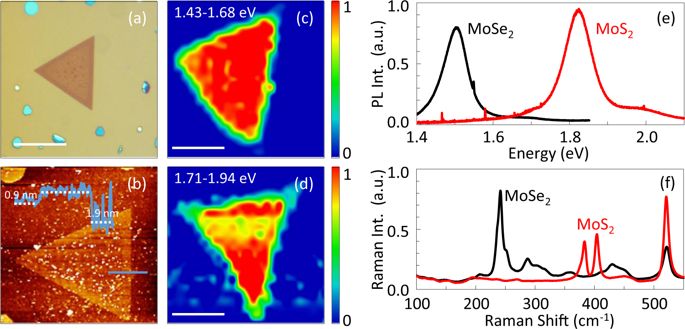npj 2D Materials and Applications ( IF 9.1 ) Pub Date : 2018-04-30 , DOI: 10.1038/s41699-018-0056-4 Hossein Taghinejad , Ali A. Eftekhar , Philip M. Campbell , Brian Beatty , Mohammad Taghinejad , Yao Zhou , Christopher J. Perini , Hesam Moradinejad , Walter E. Henderson , Eric V. Woods , Xiang Zhang , Pulickel Ajayan , Evan J. Reed , Eric M. Vogel , Ali Adibi

|
Composition modulation of two-dimensional transition-metal dichalcogenides (TMDs) has introduced an enticing prospect for the synthesis of Van der Waals alloys and lateral heterostructures with tunable optoelectronic properties. Phenomenologically, the optoelectronic properties of alloys are entangled to a strain that is intrinsic to synthesis processes. Here, we report an unprecedented biaxial strain that stems from the composition modulation of monolayer TMD alloys (e.g., MoS2xSe2(1 - x)) and inflicts fracture on the crystals. We find that the starting crystal (MoSe2) fails to adjust its lattice constant as the atoms of the host crystal (selenium) are replaced by foreign atoms (sulfur) during the alloying process. Thus, the resulting alloy forms a stretched lattice and experiences a large biaxial tensile strain. Our experiments show that the biaxial strain relaxes via formation of cracks in interior crystal domains or through less constraint bounds at the edge of the monolayer alloys. Griffith’s criterion suggests that defects combined with a sulfur-rich environment have the potential to significantly reduce the critical strain at which cracking occurs. Our calculations demonstrate a substantial reduction in fracture-inducing critical strain from 11% (in standard TMD crystals) to a range below 4% in as-synthesized alloys.
中文翻译:

通过成分调制的二维半导体合金中的裂纹的形成引起的应变松弛
二维过渡金属二硫化碳(TMD)的成分调制为具有可调节光电特性的范德华合金和横向异质结构的合成引入了诱人的前景。从现象学上讲,合金的光电特性与合成过程固有的应变纠缠在一起。在这里,我们报告了前所未有的双轴应变,其源于单层TMD合金的成分调制(例如MoS 2 x Se 2(1- x)),并在晶体上造成断裂。我们发现起始晶体(MoSe 2)无法调整其晶格常数,因为在合金化过程中主体晶体(硒)的原子被外来原子(硫)替代。因此,所得合金形成拉伸的晶格并经历大的双轴拉伸应变。我们的实验表明,双轴应变通过内部晶体域中裂纹的形成或单层合金边缘处的约束约束较小而松弛。格里菲斯(Griffith)的标准表明,缺陷与富硫环境相结合,有可能显着降低产生裂纹的临界应变。我们的计算表明,在合成合金中,导致断裂的临界应变从11%(在标准TMD晶体中)显着降低到低于4%。











































 京公网安备 11010802027423号
京公网安备 11010802027423号